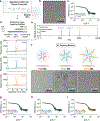Surface Engineering of FLT4-Targeted Nanocarriers Enhances Cell-Softening Glaucoma Therapy
- PMID: 34232612
- PMCID: PMC9131393
- DOI: 10.1021/acsami.1c09294
Surface Engineering of FLT4-Targeted Nanocarriers Enhances Cell-Softening Glaucoma Therapy
Abstract
Primary open-angle glaucoma is associated with elevated intraocular pressure (IOP) that damages the optic nerve and leads to gradual vision loss. Several agents that reduce the stiffness of pressure-regulating Schlemm's canal (SC) endothelial cells, in the conventional outflow pathway of the eye, lower IOP in glaucoma patients and are approved for clinical use. However, poor drug penetration and uncontrolled biodistribution limit their efficacy and produce local adverse effects. Compared to other ocular endothelia, FLT4/VEGFR3 is expressed at elevated levels by SC endothelial cells and can be exploited for targeted drug delivery. Here, we validate FLT4 receptors as clinically relevant targets on SC cells from glaucomatous human donors and engineer polymeric self-assembled nanocarriers displaying lipid-anchored targeting ligands that optimally engage this receptor. Targeting constructs were synthesized as lipid-PEGx-peptide, differing in the number of PEG spacer units (x), and were embedded in micelles. We present a novel proteolysis assay for quantifying ligand accessibility that we employ to design and optimize our FLT4-targeting strategy for glaucoma nanotherapy. Peptide accessibility to proteases correlated with receptor-mediated targeting enhancements. Increasing the accessibility of FLT4-binding peptides enhanced nanocarrier uptake by SC cells while simultaneously decreasing the uptake by off-target vascular endothelial cells. Using a paired longitudinal IOP study in vivo, we show that this enhanced targeting of SC cells translates to IOP reductions that are sustained for a significantly longer time as compared to controls. Confocal microscopy of murine anterior segment tissue confirmed nanocarrier localization to SC within 1 h after intracameral administration. This work demonstrates that steric effects between surface-displayed ligands and PEG coronas significantly impact the targeting performance of synthetic nanocarriers across multiple biological scales. Minimizing the obstruction of modular targeting ligands by PEG measurably improved the efficacy of glaucoma nanotherapy and is an important consideration for engineering PEGylated nanocarriers for targeted drug delivery.
Keywords: FLT4; IOP; VEGFR3; drug delivery; nanoparticle; rational design; targeting ligand.
Figures





References
-
- Tham Y-C; Li X; Wong TY; Quigley HA; Aung T; Cheng C-Y Global Prevalence of Glaucoma and Projections of Glaucoma Burden through 2040. Ophthalmology 2014, 121, 2081–2090. - PubMed
-
- Mao LK; Stewart WC; Shields MB Correlation Between Intraocular Pressure Control and Progressive Glaucomatous Damage in Primary Open-Angle Glaucoma. Am. J. Ophthalmol 1991, 111, 51–55. - PubMed
-
- Quigley HA; Nickells RW; Kerrigan LA; Pease ME; Thibault DJ; Zack DJ Retinal Ganglion Cell Death in Experimental Glaucoma and after Axotomy Occurs by Apoptosis. Invest. Ophthalmol. Visual Sci 1995, 36, 774–786. - PubMed
-
- Allingham RR; de Kater AW; Ethier CR; Anderson PJ; Hertzmark E; Epstein DL The Relationship between Pore Density and Outflow Facility in Human Eyes. Invest. Ophthalmol. Visual Sci 1992, 33, 1661–1669. - PubMed
-
- Johnson M; Shapiro A; Ethier CR; Kamm RD Modulation of Outflow Resistance by the Pores of the Inner Wall Endothelium. Invest. Ophthalmol. Visual Sci 1992, 33, 1670–1675. - PubMed
MeSH terms
Substances
Grants and funding
LinkOut - more resources
Full Text Sources
Other Literature Sources
Medical
Miscellaneous

